The electricity grid has become increasingly dependent upon information and communication technologies. Advances in sensor, networking, software technologies, and increases in their deployment are continuing apace, adding to this dependence.
According to Matt Wakefield, director of EPRI’s Information, Communication, and Cyber Security Program, this interdependence is a necessity of an integrated grid. “Devices and systems need to be interoperable and seamlessly connected. Just a few examples include the growing need to communicate with and manage distributed energy resources like solar photovoltaic installations for grid support, enabling the utility workforce with new tools, and adding intelligence at the grid edge—and doing all this in a secure manner. Not having a platform in place to be able to quickly adopt innovative technologies has been a barrier, forestalling the benefits associated with advanced systems and networks.”
Wakefield’s comments stem from the initial results from a recent demonstration of a multi-year EPRI Breakthrough Technology Innovation project. This project was initiated to help utilities with the development of an open enabling platform that will support the integration of the electric grid with information and communication technology (ICT) infrastructure.
Convergence, as defined by the U.S. Department of Energy,1 “is the transformation of two or more networks or systems to share resources and interact synergistically via a common and seamless architecture, thus enabling new value streams.”
In collaboration with multiple industry partners, EPRI’s goal is to help utilities create their own ‘common and seamless architecture’ by creating an open enabling platform.
An Open Enabling Platform
EPRI’s open enabling platform (OEP) brings together four elements supporting seamless and secure interoperability among conventional power generation and delivery systems, back-office networks, distributed resources, and the integrated grid.
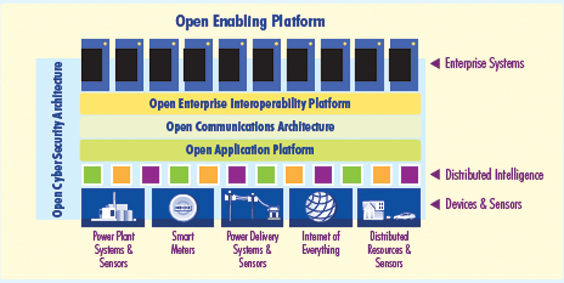
The platform is being designed for adoption by electric utilities at any stage of technology deployment. Following this design goal gives technology developers the incentive to pursue open, standards-based solutions. The goal of the OEP is to maintain the functionality of existing systems and devices that have remaining useful lifetimes—while being sufficiently agile to take advantage of rapidly evolving technologies and accommodate ICT innovations and grid-connected applications not currently deployed.
Four distinct but interconnected elements of an OEP are being incorporated in EPRI‘s testbed.
- Open enterprise enabling platform – ties together all elements of an open enabling platform to achieve interoperability between applications, software, services and systems across the utility enterprise, with partners, and beyond the meter. The goal is for disparate utility systems – modern, legacy, and emerging – to interact and work together through advances in semantic messaging, including the incorporation of non-standard messages into existing standards.
- Open application platform – analogous to the operating systems of smart phones and tablets, the open application platform will provide secure access to internal data elements residing in diverse systems and sensors. This will enable development of apps that expand functionality and increase the lifecycle value of utility devices such as advanced meters, supervisory control and data acquisition system networks, field transmitters, communications gateways, capacitor banks, regulators, switches, and other controllers.
- Open communications architecture – an architecture that enables IP-based innovations in wired, wireless, and powerline carrier communications to provide reliable, robust, high-bandwidth, low-cost communications. This will allow access to systems and sensors in challenging operating environments and at utility sites, the edge of the grid, and beyond.
- Open cyber security architecture – an architecture to integrate the disparate localized solutions required for the protection and monitoring of systems and sensors internal and external to the enterprise. These architectures will span the open interoperability and application platforms and associated systems and sensors, enabling both centralized and distributed system analysis, protection, and control strategies.
The progress being made in the development for each of these elements was demonstrated in EPRI’s Knoxville Labs in October 2015.
Wearable Computers and the Enterprise Interoperability Platform
EPRI is developing use cases, data models, and a conformance testing platform to support interoperability evaluations for the enterprise platform. In the first year, the focus has been ‘Wearable Computer to Work Management System Integration,’ with development of standards-based messaging infrastructure.
Applications of wearable computers include augmented reality, which is a live, direct or indirect view of a physical real-world environment whose elements are augmented by computer generated sensory input such as sound, video, graphics or geospatial data. If you have watched a U.S. football game on television, you have seen augmented reality: the computer-generated yellow first-down line overlaid on the image of the real field.
There are multiple uses of wearable computers using augmented reality, for example, when assets can be mapped and located as shown below. Wearable computers can also include sensors that can measure data not readily detected by a field worker with the naked eye, such as heat behind a panel or an electrical charge in a fence.
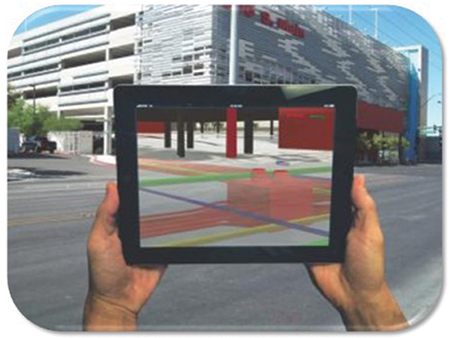
Example of a tablet computer, overlaying augment reality
information on a display, showing the location of utility assets.
The wearable computer market has exploded in recent years, with new entrants developing their own new messaging infrastructures. This creates a dilemma for utilities that want to acquire the technology. As noted by Dr. Gerald Gray, a technical executive at EPRI who is leading the development of the open enterprise platform, “Regardless of the initial vendor selected, chances are that a particular device will not be available in the next five years as the wearable computer domain shakes out. Like the desktop computer market of the 1980s, there are multiple products, and many are likely to exit the market or be acquired.”
To address this issue EPRI is creating a standards-based messaging infrastructure for wearable computer technology based on IEC 61968-6 Maintenance & Construction, which was published in 2015. With standards-based integration, a utility will need only change the device – the messaging infrastructure survives intact. Per Gray, “Being able to change the device helps ensure ‘no regrets’ investment decisions.”
EPRI demonstrated the integration of a Raspberry-Pi based wearable computer at its year-one demonstration, generating a work order using CIM2 messages from the wearable computer, which captured and attached pictures, video and geospatial coordinates. Data was transferred in CIM-based work order messages into the OpenWMS (workflow management system) tool.
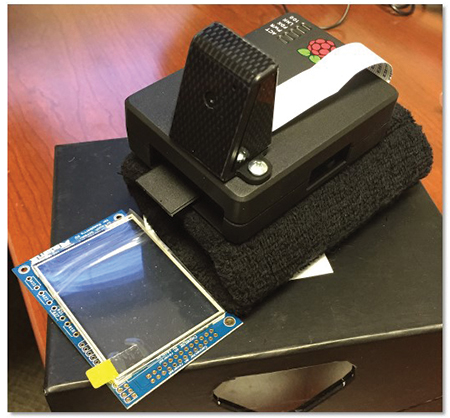
A Raspberry-Pi based wearable computer produced CIM-based work order messages
EPRI has also created a test harness, which is software that allows testing of messages under a variety of conditions, to verify that a client’s messages can be consumed if they are correctly formed. “Having a standard way of messaging lowers the barriers for vendor adoption of this infrastructure;” said Gray, “once they comply with the messaging, vendors can then focus on price, performance, services, and features of their particular devices.”
Smart Meters and the Open Application Platform
In the same fashion that smart phones allow for enhanced functionality with available applications (users can choose from 1.6 million apps for Android and 1.5 million apps for iPhone as of July 20153), the open application platform will allow utilities and others to independently add new applications to products and establish uniform functionality across multiple product brands.
EPRI is creating an open application platform, extending a smart meter program interface to address a broader array of use cases. Laboratory and field tests of an open platform prototype are being conducted in coordination with industry partners, using apps that introduce new functionalities to high-priority devices.
At the year-one demonstration, Ed Beroset, principal technical leader at EPRI, offered a vision of the open application platform, “That starts by imagining you had a word processing appliance, an email appliance and a web browsing appliance. Now let’s say you want to do some calculations with a spreadsheet. Instead of buying yet another single-purpose appliance, you’d probably prefer to have a more general purpose device that could do all four of those applications and more.”
This is the idea behind the open application platform, which provides a secure, open, standardized platform on which new applications can be built. The demonstration unit in the photo below shows two different applications running simultaneously on hardware similar to that in current generation smart meters. Instead of being limited to only the functions that were originally imagined by a meter designer, the open application platform allows utility personnel to add new functions, even after device installation.
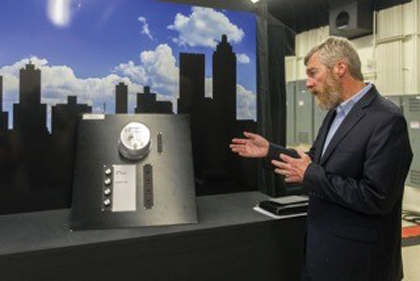
Photo by Saul Young/Knoxville News Sentinel
Ed Beroset discusses creating apps for advanced meters at
the EPRI open enabling platform year-one demonstration.
”Applications in this platform could be long term or only be deployed temporarily as needed, such as an application that validates transformer association with a meter,” Beroset said.
Vendor Devices and Open Communications Architecture
EPRI recognizes that an integrated grid relies on telecommunications to transfer data between devices – between the field and enterprise – and now with Open Field Message Bus (OpenFMB), between devices in the field. Devices and systems need to communicate with each other and the utility back office to be interoperable.
Tim Godfrey, Principal Technical Leader at EPRI, working with Ben Rolfe, Strategic Technology Consultant with Blind Creek Associates, and Gene Falendysz, Principal Design Engineer at Itron, demonstrated how the open communications platform can work, implementing the Field Area Network (FAN) standard from the industry group Wi-SUN Alliance. The standard enables interoperable communication networks.
“Just as the WiFi Alliance, Bluetooth, and USB are ubiquitous plug-and-play items in your life,” said Ben Rolfe, “the EPRI Wi- SUN communications open platform can become ubiquitous in the utility industry.”
The interoperability tests at the demonstration—communicating with an Itron device—proved successful. EPRI, Itron, and other Wi-SUN Alliance members participate in an ongoing series of interoperability testing events. These tests help identify any discrepancies in the interpretation of the specifications, in which case the specifications can be refined to a point of yielding only one interpretation.
Gene Falendysz reported that Itron, as well as others in the Wi-SUN Alliance, are behind standardizing on an IP network and seeing the ecosystem evolve to enable communication between disparate devices and systems in any type of operating environment.
EPRI’s Godfrey pointed out that the standard focuses on metering, but it can also support distributed energy resources and some types of distribution automation. “Going forward, we plan to achieve Wi-SUN certification for our platform. We will also develop application layer tools that will provide a new level of visibility into the network. We hope to see our platform used as a basis for innovative products, and used by utilities as a ‘gold standard’ for confirming interoperability.”
Open Cyber Security Architecture
How can an open enabling platform be achieved in a secure manner? EPRI’s first year activities started with the integration of secure authentication for the Distributed Network Protocol, version 3 (DNP3).
Glen Chason, Senior Technical Leader in Cyber Security at EPRI, explained that DNP3 is widely used in the utility industry and that secure authentication with DNP3 has been the initial focus because field devices can support this type of security. “It is well suited to the prevention of ‘man-in-the middle’ attacks, to which field devices may be especially vulnerable,” said Mr. Chason. The man in the middle is an attacker who masquerades as a master to an outstation and as the outstation to the master. Verifiable authentication prevents the attacker’s access at the out- and master-stations.
A Distributed Energy Resource Management System (DERMS) that provides a testbed for evaluating interoperability with other secure authentication solutions was used for the OEP testbed demonstration, and it is allowing for the testing of both devices and architectures.
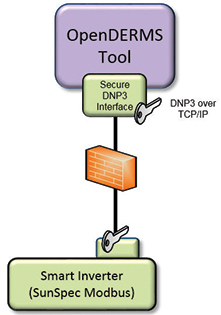
EPRI plans to validate the instantiation of a Distributed Key Management Protocol server to expand the capabilities of the testbed. Also planned for the future is an implementation of the Open Field Message Bus (OpenFMB) framework testbed for security testing of the framework.
This cyber security platform can serve as an ongoing testbed for evaluating proposed cyber security solutions for end-to-end interoperability and the security of field devices, open application platforms, communications, and the whole enterprise.
Conclusion
The EPRI demonstration was just a glimpse into the steps to creating an open enabling platform. In coming years, EPRI hopes to help utilities achieve interoperability and the optimal convergence of the electricity and ICT infrastructure—and accelerate adoption of rapidly evolving technologies in a manner that is secure and optimizes operations and value.
For more information about EPRI’s Information, Communication and Cyber Security work visit www.epri.com.
About the Author
 Karen George, Technical Leader, Information and Communications Technology in EPRI’s Power Delivery & Utilization program, has more than 30 years of experience in the energy industry, specializing in technology transfer related to renewable energy resources and end-use efficiency. She is currently engaged in projects related to integration of distributed energy resources, most recently with the EPRI Smart Grid Demonstration Initiative, a seven-year project involving 24 utilities in the U.S., Australia, Canada, France, Ireland, and Japan.
Karen George, Technical Leader, Information and Communications Technology in EPRI’s Power Delivery & Utilization program, has more than 30 years of experience in the energy industry, specializing in technology transfer related to renewable energy resources and end-use efficiency. She is currently engaged in projects related to integration of distributed energy resources, most recently with the EPRI Smart Grid Demonstration Initiative, a seven-year project involving 24 utilities in the U.S., Australia, Canada, France, Ireland, and Japan.
1 Pacific Northwest National Laboratory, The Emerging Interdependence of the Electric Power Grid & Information and
Communication Technology, PNNL-24643, August 2015.
2 CIM is the Common Information Model, a standard developed by EPRI and the electric power industry to
support the exchange of data and messages. See the freely available Common Information Model Primer:
Third Edition. EPRI, Palo Alto, CA: 2015. 3002006001.
3 The number of smart phone applications available is from satista.com/








